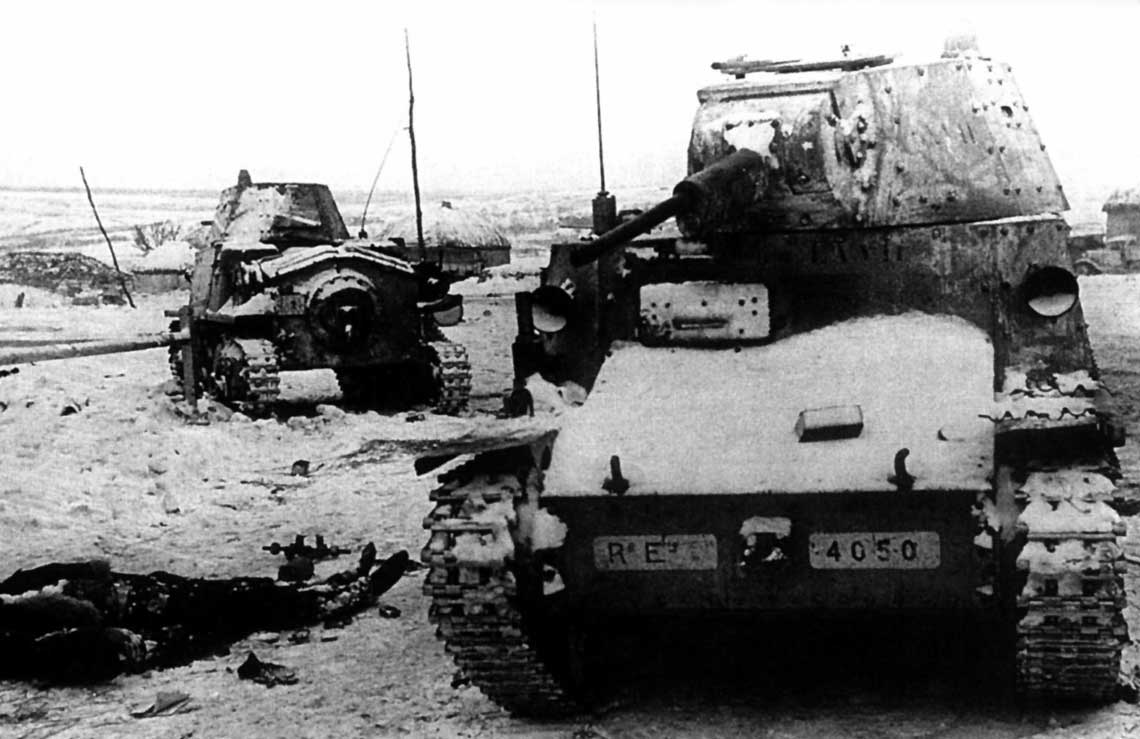
Italian armored forces on the Eastern Front

Italian armored forces on the Eastern Front
On June 2, 1941, during a meeting with the leader and chancellor of the Reich, Adolf Hitler, at the Brenner Pass, Italian Prime Minister Benito Mussolini learned of Germany's plans to attack the USSR. This did not come as a surprise to him, since on May 30, 1941, he decided that with the start of the German operation Barbarossa, Italian units should also take part in the fight against Bolshevism. Initially, Hitler was against it, arguing that it was always possible to provide decisive assistance, Duce, by strengthening his forces in North Africa, but he changed his mind and on June 30, 1941, he finally accepted the idea of participating an Italian ally in the Russian campaign.
Cavalry Tankmen – Gruppo Carri Veloci “San Giorgio”
On the day of the German aggression against the USSR (June 22, 1941), General Francesco Zingales was appointed commander of the Italian Expeditionary Force in Russia (Corpo Spedizione and Russia - CSIR), but during a trip to the front he became seriously ill, and he was replaced by General Giovanni Messe. The core of the CSIR consisted of units of the 4th Army stationed in northern Italy. These were: the 9th Infantry Division "Pasubio" (General Vittorio Giovanelii), the 52nd Infantry Division "Turin" (General Luigi Manzi), Prince Amadeo d'Aosta (General Mario Marazziani) and the motorized brigade "Black Shirt" "Tagliamento ". In addition, separate motorized, artillery, engineer and sapper units were sent, as well as rear forces - a total of 3 thousand soldiers (including 62 officers), armed with about 000 guns and mortars, and 2900 vehicles.
The main fast force of the Italian Expeditionary Force in Russia was the Panzer Group San Giorgio, which was part of the 3rd Fast Division. It consisted of two cavalry regiments and a Bersaglieri regiment, consisting of three motorized battalions and a battalion of light tanks. The cavalry regiments were actually mounted, and the bersaliers were equipped with folding bicycles and, if necessary, could use vehicles. The 3rd Fast Division was additionally supported by a group of light tanks - tankettes CV 35. The isolation of this type of unit was favored by the fact that the Italian armored forces were originally intended to interact with infantry, motorized units and fast cavalry units. This was to be useful to the Italian armored personnel carriers on the Eastern Front.
In total, three fast divisions were created: 1. Celere Division "Eugenio di Savoia" with headquarters in Udine, 2. Celere Division "Emanuele Filiberto Testa di Ferro" in Ferrara and 3. Celere Division "Prince Amedeo Duca D'Aosta" in Milan. In peacetime, each of these divisions had a tank battalion. And so, in order, each division was assigned: I Gruppo Squadroni Carri Veloci "San Giusto" with CV 33 and CV 35; II Gruppo Squadroni Carri Veloci "San Marco" (CV 33 and CV 35) and III Gruppo Squadroni Carri Veloci "San Martino" (CV 35), which was soon renamed "San Giorgio". Squadrons of light tanks, consisting of three tankette squadrons, were formed from cavalry troops and were located in the same garrison as the rest of the division. This made it easier to work together. Shortly before the start of the war, the squadrons were reorganized - so that now they consisted of a control company and four squadrons of 15 light tanks each - a total of 61 tankettes, including 5 with a radio station. The equipment included a passenger car, 11 trucks, 11 tractors, 30 tractors, 8 ammunition trailers and 16 motorcycles. The staff strength was 23 officers, 29 non-commissioned officers and 290 enlisted men.
The basis of Italian armored vehicles were light tanks (tankettes) CV 35, the first units of which rolled off the assembly line in February 1936. They were armed with two 8mm machine guns. Versions with a 20 mm cannon, a flamethrower and a commander were also produced. Serial production ended in November 1939. According to the most reliable data of Nicola Pignato, 2724 tankettes CV 33 and CV 35 were produced, of which 1216 were sold abroad. In July 1940, the Italian army had 855 tankettes in service, 106 were under repair, 112 were used in training centers, and 212 were in reserve.
The Italian units began their operations in Ukraine with an insurance march, after unloading from railway transport, to the combat formation of troops. Upon arrival, the Italians were surprised by the large number of enemy soldiers and the huge amount of equipment used and destroyed by them. The Pasubio Infantry Division and the 3rd High-Speed Division, using trucks and horses, approached the combat area the fastest. The last to arrive was the marching infantry division Turin. The Italian units reached full combat readiness on August 5, 1941.